pometablava said:
I agree with you about defining "autonomous" this way. In fact, the UCAV you're describing is practicable today.
Well...yeah. I was pretty much describing the Global Hawk

But I think it's behaviour is too predictable and thus not survibable out of this simple task of carrying a bomb from point A to B.
Ideally that's where stealth comes in. A commander could assign it waypoints, either pre-flight or during flight, to make it less predictable. It could also terrain-hug, either with the assistance of an onboard radar or (perhaps even preferably) using a GPS command link.
Besides, as Jemiba noted, it's not a flexible weapon for that mediatic wars of the XXI Century. I mean if an UCAV has to be operated in a highly cooperative environment such a modern combat force it needs to be much more "autonomous".
How so? I'm afraid I don't follow. If it needs to loiter, a commanding officer can simply order it to loiter at a waypoint. If it needs to get to a certain location in a hurry, a commanding officer will simply order it to.
Close air support will be a bit tricky, I'll admit. There will have to be some sort of means of visually identifying targets or an ability to illuminate targets by Army grunts or Marines. But this can probably be overcome.
I've outlined what I think should be the target goals of UAV development on here and some other forums before. A small, compact, highly stealthy platform with a very simple flying wing or "2D" planform - perhaps a smaller version of an X-45 or X-47, perhaps even with just a single, low to mid-thrust (but high efficiency) engine like a JD15, and maybe with a warload of no more than 4,000 lbs, with the idea of making cheap "swarming" platforms and reducing the craft's signatures the old-fashioned way of just making it smaller. There would be no air-to-air capability whatsoever for the interest of cost; the idea would be to catch enemy aircraft on the ground or rely on surface-to-air missiles. Of course there would be no reason for the craft to not carry AAMs, but it would have to be with the understanding that the craft is not stressed for high-G flight, so BVR combat would be preferred. It might not even carry an onboard radar, instead relying on a GPS link, and it might be slaved to another radar platform such as AWACS/JSTARS or AEGIS. It might even be programmed to return to base using last known GPS information if that link were to be broken.
The craft would also have a commanding officer who would "pilot" the craft using a stylus on a touch-screen to assign it waypoints and issue fire orders. The commanding officer would also be able to give the craft altitude and speed orders. "Piloting" the craft would probably end up resembling ATC operations more than anything.
The idea would also be to make it as autonomous as possible without a lot of processing power or "AI" behind it. Not only would it be cheaper, but it might also assuage fears of these things going rogue




